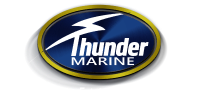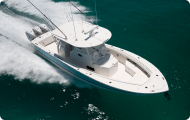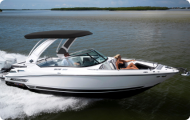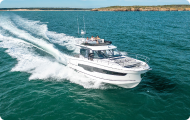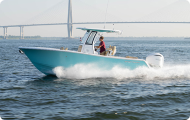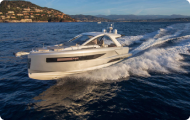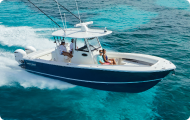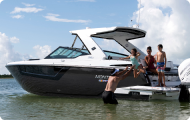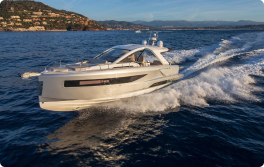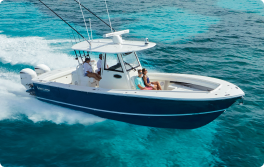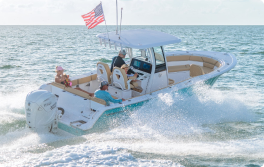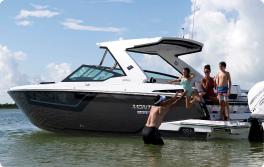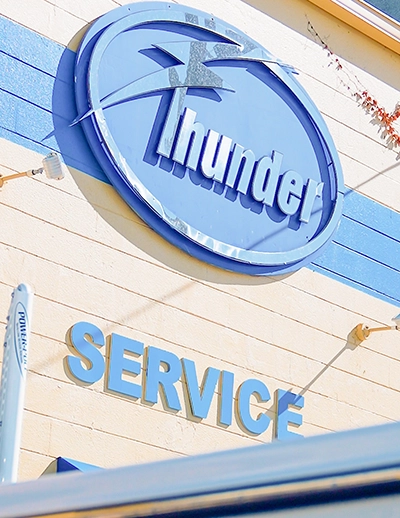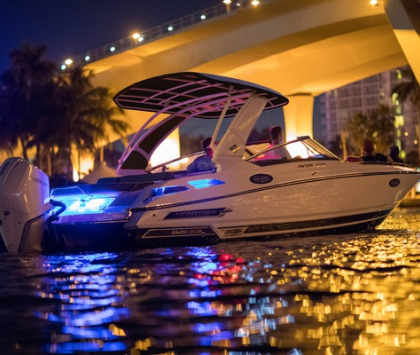A VHF radio is a critical piece of safety equipment that should be on board every powerboat, and knowing how to use it could save the life of you and your passengers, so read the owner’s manual for your radio to become familiar with its functions. That same VHF marine radio can be used to communicate with other boats, with draw bridges and locks, and with marina operators.
Basics Steps for Using a VHF Radio
- Turn on the VHF unit and adjust the squelch by turning the knob until the static stops.
- Tune to channel 16, the channel monitored by the U.S. Coast Guard.
- Perform a radio check to ensure your unit is functioning properly—do not use channel 16.
- Use an “open channel” to perform the check (channels 68, 69, 71, 72 and 78A).
- Turn the radio to one-watt power setting, and key the microphone.
- Call “radio check” three times, followed by your boat name and location.
- Wait for a reply confirming someone has heard your transmission.
- For general communications, always use channel 16.
Start by turning on the VHF unit and adjusting the squelch. Turn the squelch knob until you hear static, and then turn the knob back just until the static stops. Tune the radio to channel 16, which is the channel the Coast Guard constantly monitors. Keep your unit set to channel 16 so you can hear emergency calls or transmissions from the Coast Guard.
You’ll want to confirm that your radio is functioning by performing a radio check. Do not use channel 16 for a radio check. Instead, use one of the “open channels” (68, 69, 71, 72 and 78A) which are designated for conversation. Turn the radio to its one-watt power setting, key the microphone and call “radio check” three times followed by your boat name and location; so for example “radio check radio check radio check this is Big Daddy in North Harbor Marina.” Then wait for a reply confirming that someone has heard your transmission. Sea Tow operates a network of automated radio-check stations in many parts of the country as a public service (check at Sea Tow to find the correct frequency in your area).
For general communication, start by hailing the other party on channel 16; for example to reach your buddy on Some Fun you’d call their boat name twice, followed by your boat name and “over” so it would so like this:
- “Some Fun Some Fun. Big Daddy. Over.”
- Then Some Fun should respond “Big Daddy this is Some Fun. Over.”
- You’ll reply with an open channel to switch to, for example “69.” Then both parties will switch to channel 69 to exchange information.
- After your initial transmission on channel 16, wait at least two minutes before hailing the other party again. If you still don’t get a reply wait 15 minutes and try again. The point is not to pollute channel 16 with unnecessary transmission.
- If the other party is close by, switch your radio to 1 watt (low power) so that your transmission does not travel so far. This lets distant boaters also use the channel.
The open VHF frequencies are intended for operational messaging, so it’s OK to share weather info, but not to talk sports. End each transmission with “over” and when you are done with the conversation say your boat name and out, “Big Daddy out,” which let’s everyone know you are done using that channel.
Using a VHF Radio in an Emergency
- Tune the radio the channel 16 and full power.
- If lives are in danger transmit “Mayday Mayday Mayday” and your vessel name.
- Wait for the Coast Guard to respond and be ready to reply with your location, ideally with latitude and longitude from GPS.
- If your situation is bad but not life-threatening, use the call “pan-pan.”
Types of VHF Marine Radios
A VHF marine radio may be hand-held or fixed-mount.
- A fixed-mount VHF unit is permanently installed on the boat and powered by the boat’s electrical system.
- The hand-held version is portable and is battery-powered, so it will still function if the boat’s battery is dead or the electrical system fails, and can be used if you are forced to abandon ship.
Many hand-held units are also waterproof and will float. For this reason a hand-held unit is a great back-up to a more-powerful fixed-mount VHF.
Digital Selective Calling
Digital Selective Calling (DSC) is a feature on all fixed-mount radios that with the push of one button sends a signal with your location to the Coast Guard. However, for DSC to work the radio must either have its own internal GPS receiver or be linked to another GPS on the boat, such as a chart plotter. Many boat owners are not aware that the radio needs to be linked to GPS, so make sure you handle this task right away.
